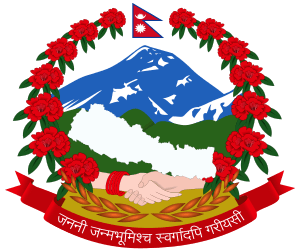Kingdom of the Videhas
| Kingdom of the Videhas | |||||||
|---|---|---|---|---|---|---|---|
| uncertain–500 BCE | |||||||
.png) The Kingdom of the Videhas (Mithila) and other kingdoms of the late Vedic period | |||||||
| Capital | Either Janakpur (in present-day Nepal),[1] or Baliraajgadh (in present-day Madhubani district, Bihar, India). [2][3] | ||||||
| Common languages | Sanskrit | ||||||
| Religion | Vedic-Hinduism[4] | ||||||
| Government | Monarchy | ||||||
| Janaka | |||||||
| Historical era | Iron Age | ||||||
• Established | uncertain | ||||||
• Disestablished | 500 BCE | ||||||
| |||||||
| Today part of |
| ||||||
The Kingdom of the Videhas (also known as Mithila and Tirabhukti[5]) was an ancient kingdom in Late Vedic India[6] which rose to prominence under King Janaka (c. 8th-7th centuries BCE). The ancient kingdom's territory is presently located in Mithila region of Northern and eastern Bihar of India and the eastern Terai of Nepal.[5][7]
History
During the late Vedic period (c. 900 – c. 500 BCE), Videha became one of the major political and cultural centers of South Asia, along with Kuru and Pañcāla.[8] Late Vedic literature such as the Brahmanas and the Brihadaranyaka Upanishad both mention Janaka, as a great philosopher-king of Videha, renowned for his patronage of Vedic culture and philosophy, and whose court was an intellectual centre for Rishi (sages) such as Yajnavalkya.[9] Raychaudhuri suggests 8th- to 7th-century BCE range, while Witzel suggests c. 750 to 500 BCE for the Brahmanas and Upanishads composition period in Videha.[10][note 1] The Vedic school of Aitareyins probably moved to Videha and other centers of scholarship, during the late Vedic period.[11]
The region and culture of Videha is often mentioned in Hindu literature.[12] The texts mention the idea of royal dynasty and the tradition of philosopher-kings who renounce, with examples including Nami (or Nimi in some texts), Janaka and other kings.[12] Their stories are found in ancient surviving Hindu, Buddhist and Jaina texts, suggesting that renunciation by kings was a respected tradition before the birth of Buddha, and that this tradition was also broadly accepted in regions other than Videha, such as in Pancala, Kalinga and Gandhara.[12] King Nimi or Nami of Videha is included as the 21st of the twenty four Tirthankaras in Jainism (not to be confused with closely spelled Nemi, the 22nd Tirthankara).[12]
Towards the end of the Vedic period, Videha likely became part of the Vriji (Pali: Vajji) confederation and subsequently into the Magadha empire.[13] The Videha kingdom is also mentioned in the Sanskrit epics, the Mahabharata and the Ramayana. In the Ramayana, Sita is the princess from Videha,[12] who marries Rama creating an alliance between the kingdoms of Kosala and Videha.[1] The capital of Videha, is believed to be either Janakpur (in present-day Nepal),[1] or Baliraajgadh (in present-day Madhubani district, Bihar, India).[14][15]
See also
Notes
References
- 1 2 3 Raychaudhuri (1972)
- ↑ https://hindi.news18.com/blogs/satyam/balirajharh-a-ancient-mithila-915917.html
- ↑ "Archived copy". Archived from the original on 26 October 2017. Retrieved 26 October 2017.
- ↑ Ben-Ami Scharfstein (1998), A comparative history of world philosophy: from the Upanishads to Kant, Albany: State University of New York Press, pp. 9-11
- 1 2 Dilip K. Chakrabarti (2001). Archaeological Geography of the Ganga Plain: The Lower and the Middle Ganga. Orient Blackswan. pp. 207–. ISBN 978-81-7824-016-9.
- ↑ Michael Witzel (1989), Tracing the Vedic dialects in Dialectes dans les litteratures Indo-Aryennes ed. Caillat, Paris, pages 13, 17 116-124, 141-143
- ↑ Michael Witzel (1989), Tracing the Vedic dialects in Dialectes dans les litteratures Indo-Aryennes ed. Caillat, Paris, pages 13, 17 116-124, 141-143
- ↑ Michael Witzel (1989), Tracing the Vedic dialects in Dialectes dans les litteratures Indo-Aryennes ed. Caillat, Paris, pages 13, 141-143
- ↑ H. C. Raychaudhuri (1972), Political History of Ancient India and Nepal, Calcutta: University of Calcutta, pp.41–52
- ↑ Michael Witzel (1989), Tracing the Vedic dialects in Dialectes dans les litteratures Indo-Aryennes ed. Caillat, Paris, pages 13, 39-46, 141-143
- ↑ Michael Witzel (1989), Tracing the Vedic dialects in Dialectes dans les litteratures Indo-Aryennes ed. Caillat, Paris, pages 76-77, 125
- 1 2 3 4 5 Geoffrey Samuel, (2010) The Origins of Yoga and Tantra: Indic Religions to the Thirteenth Century, Cambridge University Press, pages 69-70
- ↑ H.C. Raychaudhuri (1972), pp. 70-76
- ↑ https://hindi.news18.com/blogs/satyam/balirajharh-a-ancient-mithila-915917.html
- ↑ "Archived copy". Archived from the original on 26 October 2017. Retrieved 26 October 2017.
- Mahabharata of Krishna Dwaipayana Vyasa, translated to English by Kisari Mohan Ganguli
- The Geography of India: Sacred and Historic Places. Britannica Educational Publishing.
